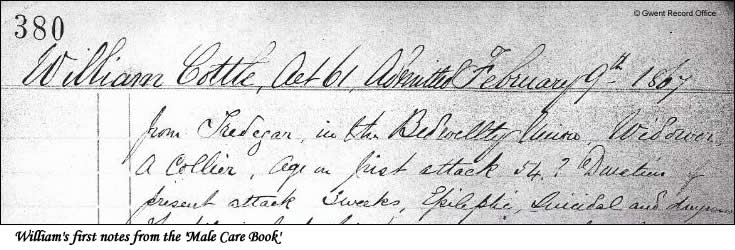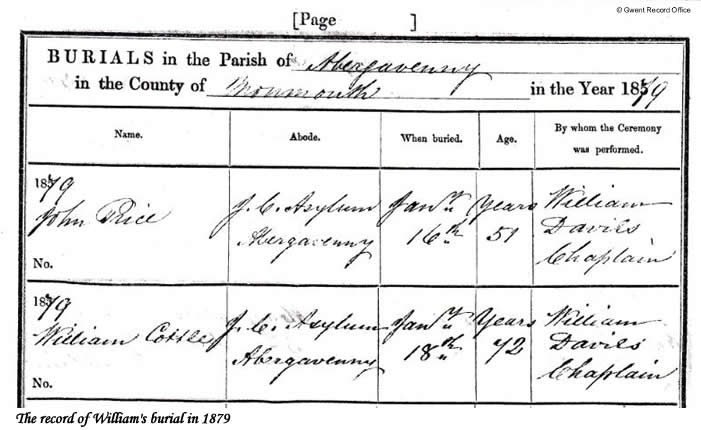By 1881 almost all of Mum’s living ancestors were in Ebbw Vale in the Welsh valleys of Monmouthshire. They had arrived there from various parts of Wales and Somerset, and the men were working in the steelworks or down one of the many pits in the area. It was fairly easy to follow the certificate trail back to 1837, but I would need parish records for those born before then. Unfortunately, the Cottles from Somerset were not exactly helpful in naming their places of birth, only giving the name of the county on the census.
I began my research before the advent of Ancestry and the only census easily available was on the 1881 census discs produced by The Church of the Latter Day Saints (LDS). A few family history societies had indexed some censuses and there were also a few available on disc, produced commercially. Other censuses, mainly unindexed, had to be searched at record offices or on film at an LDS Family History Library. I ordered the Ebbw Vale census films at the LDS one at a time and eventually discovered that John Cottle was born in Midsomer Norton c1836. There was a commercially available CD of the Somerset 1851 census, so I sent for it and discovered that John was single and living in Clandown with his father William, who was married to Louisa. I later discovered that this was a second marriage, John’s mother was Caroline née Bull. Also in the household was an older brother James described as a ‘lunitick’ [sic].
By 1861 John had married and was living in Merthyr Tydfil, and William and his wife were living nearby. William and Louisa were not to be found in Merthyr in 1871 or in Tredegar, where John was now living. I found Louisa’s death in 1866, but could not find one for William between 1861 and 1871. I abandoned the search then because I was having to use films of the General Record Office (GRO) index at the LDS Family History Library and it was very time consuming.
A few years later the Ancestry website released the 1871 census online, so I looked for William again and it was a bit of a shock to find him as an inmate in Abergavenny Asylum. I searched the GRO index again for his death registration and sent for the certificate, which told me that he had died on January 14, 1879 of a ‘fibrous brain tumour’. He had been in the asylum for at least eight years and I wondered if any of his family had been able to visit him, or if the journey had been too difficult. I felt very sad for William.
19th century literature had led me to believe that asylums were dreadful places and I imagined poor William locked away for many years in abject misery and squalor, without even the comfort of his family to visit him. Or maybe he had descended into madness and had no idea of his surroundings, maybe he had to be permanently restrained? I couldn’t leave it there.
Gwent Record Office hold the records of Abergavenny Asylum for that period and, at that time, were prepared to copy records for a fee. After a friendly and helpful exchange of emails with the archivist, and with some trepidation, I sent off a cheque.
The bald facts were recorded in the Admissions Book:-
Number of Admission: 2081
Date of Admission: July 9th 1867
William Cottle, male, aged 61, Collier
Residence of Relatives: Tredegar, John Cottle 57 Charles St.
Chargeable Union: Bedwellty
By whose Authority sent: L.J.Rowland, clergyman, John ? RO
Date of Medical Certificate: 9th July, 1867. L.G. Anthony
Form of Medical Disorder: Mania with epilepsy
Supposed Cause of Insanity: Epilepsy
Bodily Condition: Feeble
Duration of existing attacks: 3 weeks
Age on first attack: 47
Date of Discharge, Removal or Death: 1879 January 14th
There were also copies of William’s records from the ‘Male Care Book’.
This is the record of his interview on admission, unfortunately it was very difficult to read but I have attempted to transcribe the entries in the book:-
William Cottle, Act 61, Admitted February 9th 1867.
Page 380
From Tredegar in the Bedwellty Union, widower, a collier. Age on first attack 54?. Duration of present attack 3 weeks, epileptic, suicidal and dangerous. The following facts being principally gathered from the patient himself are not perhaps reliable.
About 14 years ago he was for three months a patient in Wells asylum. For about seven years he had been subject to epilepsy, fits occurring severely as often as one a week, often several together. Since five or six years ago he has suffered an ?ulucation? of left cornea from a spark striking the eye, and some time after that he found himself somewhat suddenly unable to raise the lid, he appears to have had a similar attack to the present a few years ago during which he inflicted a slight wound of throat whose cicatrix remains. He has recently had a considerable number of fits Reverend ?———-? notes that “he says he will neither eat nor drink again, that if he is left alone he will jump into the pond, or if he can find a knife he will cut his throat. Yesterday he was brought from the pit where he was working, in a most excited state having attempted to set the pit on fire to destroy himself and his fellow workmen and also attempted to cut his throat”.
On admission is in moderate bodily health and condition is black with coal dust as he left the pit. Left eye is shut and he is unable to open it. Lower half of cornea is occupied by a white cicatrix and eye inclines inwards (convergent). Can hardly be called excited but is odd in manner and says he shall eat no more and shall soon die.

I found it very upsetting to read this about my great x3 grandfather. What a horrible life he must have had, so full of unhappiness and ill health, and now he had been brought to an asylum in a desperate condition.
Nevertheless, I read on. William had regular examinations in the early weeks and these dwindled to once a year. It seems there was never any question of a discharge but I was pleased that, for the time, he was looked after quite well. William was able to work in the garden sometimes, although his fits continued. At one time he cut his forehead badly while in a fit and on another occasion he broke his elbow. Sadly it is a tale of slow decline:-
1876
October 5: The patient suffers from epileptic fits of a severe nature and nearly daily. He is for the most part dull, stupid and greatly demented only occasionally a little excited. Unemployed. BC [bodily condition] is very feeble.
1877
December 15: Epileptic fits occur frequently and he often sustains severe injuries from falls while under the influence of the fit. He is much demented and passes most of his time sleeping by the fireside. BC feeble.
These are the last entries in the register:-
1879
January 9: Has fits frequently and is now in a very feeble state. Takes food well.
January 14: Became greatly excited and extremely restless the day after the last note and died today from exhaustion at 4.
January 14: Note to Coroner: William Cottle died at 4pm on January 14th 1879 and that the apparent cause of death was fibrous tumour of the brain which lasted many years.
This diagnosis was confirmed on his death certificate.
William was buried in the grounds of Abergavenny Asylum on January 18th, 1879.

His entry into Abergavenny Asylum was not his first admission to such an institution. On his admission he said that he had previously been in Wells Asylum. The archivist of Somerset Record Office told me that they could not copy the records for me and family circumstances prevented me from going to Taunton to follow this up. However, a kind member of Family Tree Forum looked up the records for me and transcribed them:-
Wells Asylum D/H/men 17/1/3 pg 112 Case 606
Records of William Cottle, aged 50, married, 2 children, male
2nd attack, duration 3 days, admitted 7th Jan 1856
Previous History: Incomplete information, parents dead, disposition sullen, temper violent, habits industrious, (mania) can read and write, A Methodist.
Occupation: A banksman at a coal pit, Clandown, Mids. Norton.
Present State: Physically general health indifferent, pulse 80, skin cool, tongue clean, appetite poor, bowels watery, motion slow, expression silly, brown hair grey sides.
Mentally: Conduct violent towards others, conversation about his brother, ideas wandering, memory lost, affections (?), propensity to destroy himself.
Additional Particulars: Has been drinking during Christmas week and had a quarrel and fight with one of his companions. Attempted to commit suicide with a razor. His eldest child is imbicile.
Jan 9th: Has been quiet and well behaved since admission, health appears improved.
Jan 11th: Continues to improve, has gone out to work today with the attendant.
Notice of admission signed for the (?) in lunacy.
Jan 22nd: Is very industrious and is daily employed working on the grounds. There is a marked improvement in his general appearance and his conversation is rational and connected.
Feb 14th: Improvement continues both in body and mind.
Feb 21st: Keeps the coal house in good order, distributes coals.
Wishes for his discharge on account of his employment and for fear of his losing his garden ground. To be recommended for discharge on probation.
March 27th: Discharged, recovered.
William’s story is such a sad one, but probably not unusual for the time. I have been unable to trace his baptism, but have found his first marriage to Caroline in Mells in 1830. The first recorded children are twins Elizabeth and James, baptised in Clandown in 1834. It seems likely that they both suffered oxygen starvation at birth, as Elizabeth died in 1835 and James is described as an ‘imbecile’ or ‘lunitick from birth’ on various census returns. Caroline died in 1841, aged just 34, with the cause of death given as ‘decline’. William married Louisa, a widow, in 1844. The family moved to Merthyr between 1851 and 1861, leaving James behind in Clutton Workhouse where he died in February 1861.
William spent time in two asylums, which came as a bit of a shock, but I’m pleased that these places do not seem to be as bad as I had imagined and the care he received there was much better than I thought it would be. The staff do seem to have taken time to discover his history, with regular checks and notes made of his condition, and he wasn’t just shut away and forgotten about.
Of all my ancestors, William’s story is the one which has moved me the most. He had a very hard life. Working in the mines in the 19th century was dangerous and dirty work, and to go down the pit and to suffer epileptic fits underground must have been very frightening. His baby daughter died and his eldest son was unable to work or care for himself, and then he was left widowed at quite a young age. How difficult was the decision to leave James behind when they moved over the Bristol Channel to Merthyr? How did he feel when he heard James had died? Was William lonely in the asylum or did his one remaining son visit him from time to time?
I can’t help but read between the lines and attribute to him a love of gardening; here was something in which he could take pleasure, even in the asylum. William has become far more than a name and a date on my tree, and whilst it’s taken me many years to unravel his story, I’m glad that I was able to do so, recording his life for further generations, so that he won’t be forgotten.
Guinevere
© Guinevere 2009